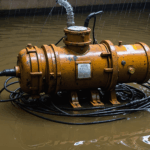During hurricane season in Tampa, unsecured outdoor items can become dangerous projectiles in high winds, potentially causing severe damage to your property and neighboring homes. According to the National Hurricane Center, wind speeds of just 74 mph can turn everyday objects into destructive missiles, while Tampa’s historical storms have recorded gusts exceeding 100 mph.
As part of your essential hurricane prep checklist, create a detailed inventory of all outdoor items that need to be secured or stored. The Insurance Institute for Business & Home Safety recommends starting this process at least 36 hours before a storm’s anticipated arrival.
- Patio furniture (chairs, tables, umbrellas)
- Grills and outdoor kitchen equipment
- Potted plants and decorative items
- Children’s toys and play equipment
- Garden tools and equipment
- Trash cans and recycling bins
For items that cannot be stored indoors, proper anchoring is crucial for wind mitigation. Florida building code expert Mike Robinson recommends using steel cables or heavy-duty straps rated for at least 160 mph winds to secure larger furniture pieces. Storage sheds should be anchored to concrete slabs or reinforced foundations using approved hurricane tie-down kits.
Recent studies by the Tampa Bay Regional Planning Council show that wind-borne debris causes approximately 30% of hurricane-related property damage in the area. Homeowners can significantly reduce this risk by implementing a systematic approach to securing outdoor items. Consider installing permanent storage solutions like deck boxes or weatherproof containers that can be quickly accessed during storm preparation.
Document the location of all stored items with photos and maintain an updated checklist of securing procedures. This documentation can prove valuable for insurance purposes and ensures nothing is overlooked during high-stress pre-storm preparations. Keep all necessary securing materials, such as bungee cords, chains, or straps, in an easily accessible location alongside your checklist.
Checking and updating hurricane shutters
Begin your Tampa hurricane prep by thoroughly inspecting and maintaining your hurricane shutters, as they serve as a critical defense system against fierce storms. These protective barriers must be in perfect working condition before the hurricane season intensifies. Many Tampa homeowners have learned through experience that last-minute shutter checks can lead to dangerous scrambles during storm warnings.
Start by examining each panel or rolling shutter for signs of rust, damage, or warping that could compromise their effectiveness. Test all manual and automatic deployment mechanisms to ensure smooth operation. For accordion-style shutters, lubricate the tracks with a silicone-based spray to prevent sticking, which is particularly important in Tampa’s humid climate.
Verify that all mounting hardware is tight and corrosion-free, replacing any questionable components with hurricane-rated alternatives. Wind mitigation experts recommend checking the rubber seals and weather stripping around the edges of each shutter, as deteriorated seals can allow water intrusion during intense storms.
Create a detailed checklist for each window and door, noting the specific type of shutter and any required tools for installation. Label all panels clearly if you use removable options, and store them in an easily accessible location. Preparation time is crucial during storm warnings, so organize your shutters in a way that allows for quick deployment.
- Replace any missing or damaged hardware immediately, keeping spare parts on hand
- Clean and lubricate all tracks and moving parts every three months
- Document the installation sequence with photos for quick reference
- Measure and mark proper panel placement to ensure rapid installation
Municipal building codes in Tampa require shutters to meet specific impact-resistance standards, so ensure your system carries the appropriate Miami-Dade County or Florida Building Code approval. If your shutters are more than ten years old, consider having them professionally evaluated to confirm they still meet current safety standards.
Inspecting the roof and gutters
Many Tampa homeowners overlook critical roof and gutter maintenance until it’s too late, leading to severe water damage during hurricanes. The most common mistake is failing to conduct regular inspections, especially in areas prone to debris accumulation. A thorough hurricane prep inspection should occur well before storm season begins.
Start by scanning your roof for loose, cracked, or missing shingles – these are often signs of wind damage from previous storms. Replace damaged shingles immediately, as even minor issues can lead to catastrophic failures during hurricane-force winds. Pay special attention to the edges and corners of the roof, where wind uplift is strongest.
Improperly sealed flashing around chimneys, vents, and skylights represents another frequently overlooked vulnerability. Ensure all flashing is properly secured and sealed with appropriate roofing cement. Wind mitigation experts recommend checking for gaps larger than 1/4 inch, which can allow water intrusion during heavy rains.
Gutters require particular attention, yet many homeowners make the mistake of:
– Neglecting to clear debris regularly
– Failing to check gutter attachments and brackets
– Ignoring proper downspout placement
– Not installing gutter guards
Create a detailed checklist for gutter maintenance:
– Remove all leaves, twigs, and accumulated debris
– Test water flow with a garden hose
– Verify all downspouts direct water at least 3 feet away from the foundation
– Check and tighten all gutter fasteners
– Install or repair splash blocks at downspout exits
One critical error is assuming small leaks or minor damage can wait until after hurricane season. According to Tampa building inspectors, even minor roof issues can quickly escalate into major problems during severe weather. Document all inspection findings with photos and maintain records of repairs for insurance purposes.
Ensure your gutters can handle Tampa’s intense hurricane rainfall by verifying they’re properly sized for your roof area. Standard 5-inch gutters might not be sufficient for larger roof surfaces, and undersized gutters can lead to overflow and foundation damage during storms.
Testing backup power systems
A reliable backup power system is essential for weathering Tampa’s hurricane season, yet many homeowners discover their generators aren’t functioning properly when they need them most. Establishing a comprehensive testing schedule can prevent this potentially dangerous situation.
Begin your hurricane prep by conducting a complete inspection of your generator system. Start the unit monthly and run it under load for at least 30 minutes. This regular exercise helps prevent fuel system issues and ensures the battery maintains proper charge. Keep detailed maintenance records, including:
– Dates of oil changes and filter replacements
– Fuel system inspections and treatments
– Battery voltage readings
– Load test results
– Run time hours
For whole-house systems, schedule professional maintenance at least twice yearly. Technicians should verify:
– Proper voltage and frequency output
– Transfer switch operation
– Fuel line integrity
– Oil and coolant levels
– Air filter condition
Create a dedicated checklist for pre-storm generator preparation:
– Fill fuel tanks and maintain a minimum 72-hour supply
– Check and clean all air intakes
– Verify oil levels and top off if needed
– Test automatic transfer switches
– Clear debris from around the unit
– Update family members on safe operation procedures
Wind mitigation experts recommend installing your generator at least 20 feet from your home’s windows and doors to prevent carbon monoxide infiltration. Ensure the installation area has proper drainage and protection from flooding, a common oversight in Tampa’s low-lying areas.
For portable generators, maintain a dedicated storage area with easy access during emergencies. Keep essential supplies nearby, including:
– Fresh fuel in properly rated containers
– Heavy-duty extension cords
– Spare filters and spark plugs
– Basic maintenance tools
– Operating manual
Test all backup power circuits quarterly to ensure critical systems remain properly connected. Label all generator-powered outlets clearly and maintain an updated list of which appliances can safely operate simultaneously without overloading the system.
Reviewing insurance and essential documents
- How often should I review my insurance policies for hurricane coverage?
- Insurance policies should be reviewed annually, at least 60 days before hurricane season begins on June 1. This timeline allows for any necessary policy adjustments and ensures coverage meets current home values and Tampa’s specific hurricane requirements.
- What essential documents should I keep in my hurricane prep kit?
- Maintain copies of insurance policies, property deeds, identification documents, and recent home inventory photos in a waterproof container. Also include medical records, banking information, and emergency contact numbers, with digital backups stored in cloud storage.
- What’s the minimum flood insurance coverage recommended for Tampa homeowners?
- The recommended coverage depends on your home’s location and value, but experts suggest enough to cover both structure and contents at full replacement cost. Tampa properties in flood zones should carry coverage that meets or exceeds their mortgage lender’s requirements, typically starting at $250,000 for the structure.
- Should I take photos of my home before hurricane season starts?
- Yes, document your entire property inside and out with detailed photos or video at least once a year as part of your hurricane prep checklist. This documentation helps expedite insurance claims and proves the pre-storm condition of your property.
- What’s the best way to store important documents during hurricane season?
- Use a waterproof and fireproof safe bolted to your home’s structure, or keep documents in a bank safety deposit box. Create digital copies and store them on encrypted cloud storage, ensuring access from any location during evacuation.











